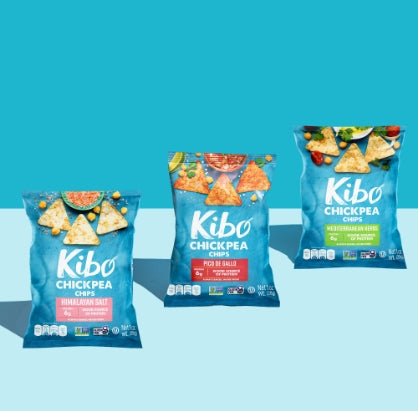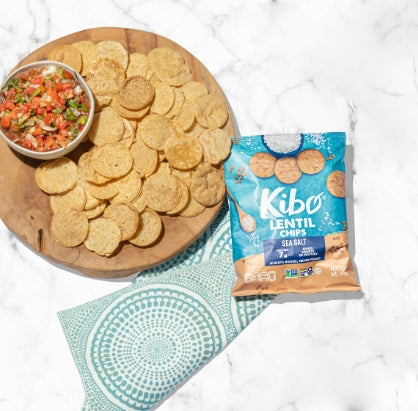What’s great in a stew, shaped like a lens, and packed with sustainable, plant-based nutrition? You guessed it: the lovable lentil! Lentils have been a source of protein and a symbol of abundance for millennia. One of civilization’s earliest crops, there’s carbonized evidence that they were eaten in Greece as far back as 11,000 B.C. With their rich history and even richer nutritional profile, we love lentils so much we even made a chip out of them! Read on to find out why lentils deserve a spot in your pantry.
First off, what are lentils?
Lentils are a type of pulse, or the edible seeds of a legume. They come in a variety of sizes and colors, like the earthy brown lentil, the peppery green lentil and the teeny red or yellow split lentil, used for dal.
Lentils make for excellent stews, soups, chilis and curries. They’re delicious in vegetarian lasagna, plant-based shepherd’s pies, stuffed bell peppers, tacos, and fritters. They don’t require pre-soaking, and they’re ready on the stove in under 20 minutes. Their substantial texture and ability to absorb flavor make them a great meat alternative, while their inexpensive price point means they’re a smart option for your wallet, too!
An earth-friendly protein
Lentils top many charts for climate-friendly foods. According to the Environmental Working Group, the lifecycle total of greenhouse gas emissions (including production, processing, transport, cooking, and waste disposal) for lentils is far lower per kilogram than other common protein sources and vegetables—at 0.9% kg C02 emitted. Compare that to dry beans or tofu at 2.0%, chicken at 6.9%, and lamb at 39.2%. Now imagine if everyone ate more lentil burgers!
Furthermore, lentils can be grown with limited irrigation and are drought tolerant, which means that they adapt their growth cycles to the amount of available water. As a result, the water footprint of lentils is considerably lower than that of many other protein sources. Cutting animal products in favor of more plant-based protein like pulses in the American diet could significantly lower our collective water usage.
And we haven’t even talked about soil yet! Unlike most crops in the U.S., which are farmed using synthetic fertilizer, lentils convert atmospheric nitrogen into natural fertilizer using bacteria from their roots. Their nitrogen-fixing properties not only nourish the lentils themselves but also replenish the soil with added fertilizer for the next round of crops. This enables a diversified crop rotation with other cereals like wheat and facilitates farming without synthetic chemicals—the kind that might end up as chemical run-off in our water supply.
Finally, lentils are typically stored dry and can last for up to four years. Unlike much other produce that you have to eat within a few days or a few weeks, lentils risk less chance of spoiling, meaning less food waste and less methane produced.
Loaded with nutrition
Turns out they’re not just good for the ground. Lentils are highly efficient sources of nutrition, made up of about 25% protein. That’s the second highest of any legume, behind soybeans! Pair them with rice, and you have complete, plant-based protein, with all the essential amino acids.
Lentils check all the boxes when it comes to macronutrients. Not only are they high in protein, they’re also high in complex carbs like fiber, and extremely low in fat (and cholesterol!). They help increase fullness and decrease appetite, while boasting a low glycemic index. And they’re a good source of micronutrients like folate, phosphorus, iron, B vitamins, potassium, magnesium and zinc!
To top it off, lentils contain phytochemicals called polyphenols, which may help fight heart disease and type 2 diabetes. Some of these polyphenols, like flavanol, are known to be antioxidants and anti-inflammatory. They may also play a part in balancing blood sugar levels.
And lest we forget, lentils are super gut friendly, containing slow-digesting resistant starch. As a trusty source of prebiotic fiber, they help feed the good bacteria in your gut, helping prevent digestive issues and leading to a healthier microbiome overall.
Kibo Lentil Chips
Our favorite way to eat lentils? In a crispy, crunchy chip!
We knew we had to use these healthy legumes in our latest take on the classic chip. Starting with yellow lentil flour as the base, we added pea protein and spinach flakes for extra nutrition and light, crispy crunch. Compared to your average chip, Kibo Lentil Chips are significantly higher in protein and lower in fat, calories and carbohydrates—score!
Check the label for yourself! The Lentil Chips contain 6-7 grams of sustainable, plant-based protein and no cholesterol. Plus, they’re gluten-free, non-GMO and vegan, so you can enjoy them with any family member or bring them to any party (they come in classic Sea Salt and fun, subtly sweet Maui Onion).
So whether ready-to-snack in chip form or stored dry by the pound in all their wholesome goodness, lentils deserve a spot in your pantry at all times.
Are you a lentil lover yet? If you still need convincing, try the new lentil chips and let us know what you think!
Written by The Kibo Team
 Reviews
Reviews






